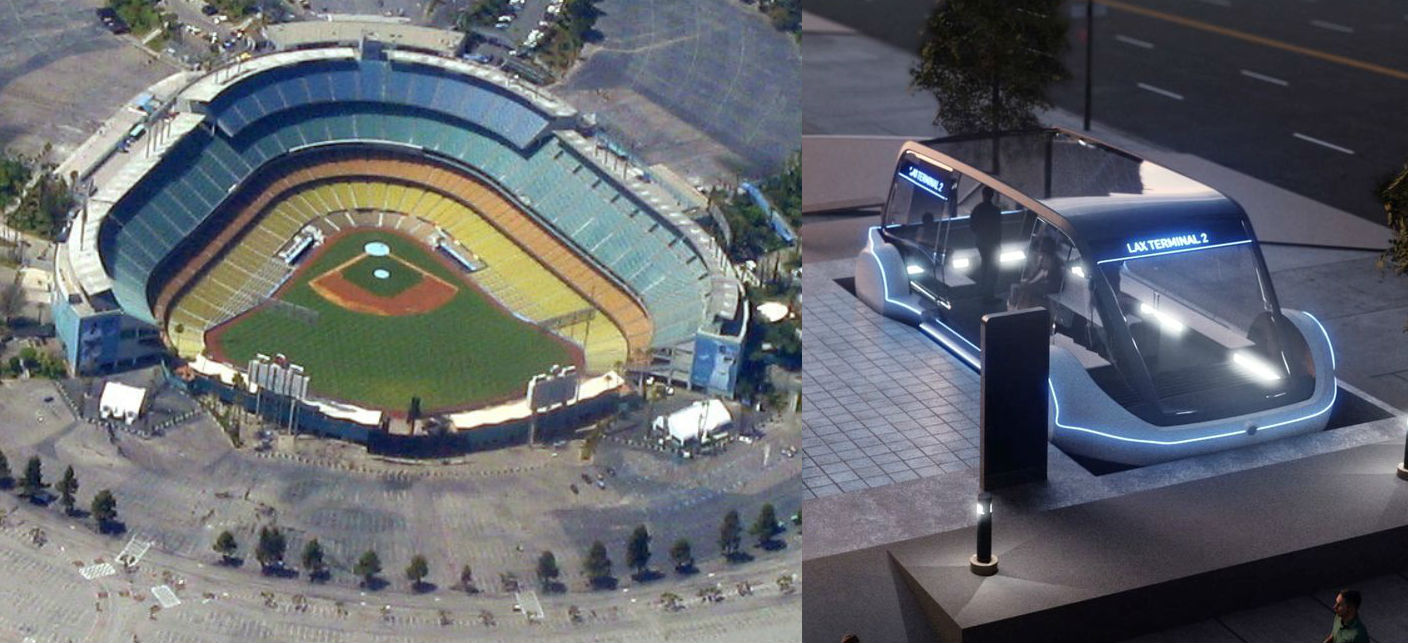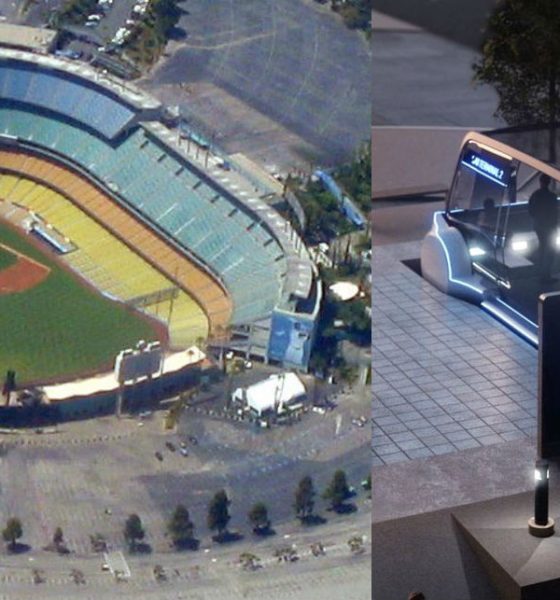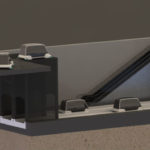

News
Elon Musk’s Boring Company proposes tunnel system leading to LA Dodgers Stadium
The Boring Company has unveiled a proposal to build a 3.6-mile tunnel system under Los Angeles designed to transport commuters to the Dodgers Stadium. Dubbed as the “Dugout Loop,” the tunneling startup’s project aims to transport people to the stadium in under 4 minutes.
The LA Dodgers Stadium is one of the city’s most prominent landmarks, where events such as games and concerts are held. The stadium in itself is massive, with a seating capacity of 56,000. Unfortunately for Los Angeles residents, getting to the Dodgers Stadium is nothing short of a traffic-inducing nightmare. During peak season, it is not rare to see vehicles being backed up for miles in seemingly unmoving traffic. This makes the travel time to the stadium, especially for commuters with their own cars, an unnecessarily long and aggravating affair.
This makes the LA Dugout Loop the perfect project for the Boring Company, a tunneling startup conceived by SpaceX and Tesla CEO Elon Musk due to his experiences in traffic. The Boring Company is currently involved in several projects, the most prominent of which is the downtown Chicago-O’Hare high-speed transport system, which is expected to break ground as soon as its permits are completed. A test tunnel under SpaceX’s headquarters in Hawthorne is also nearing completion.

The 3.6-mile Dugout Loop will begin at the Dodger Stadium property and run under Vin Scully Avenue and Sunset Boulevard. The Boring Company has not announced the starting point of the tunnel system, but there are currently three options being explored. All of these options — Vermont/Sunset, Vermont/Santa Monica or Vermont/Beverly — are selected specifically to be close to Metro Red Line stations.
The Los Angeles Bureau of Engineering (LABOE) has posted a document covering some of the finer details of Boring Company’s proposed project, including the design of the tunnels, how the electric pods in the Loop system will work, and the accessibility of the tunnels themselves. The document, which could be viewed in full here, notes that the Boring Company plans to use access shafts that would serve as tunnel access points for ventilation, emergency exit, and general access. These would be spaced approximately 0.5 miles apart, totaling about three to six locations located along the proposed Main Artery Tunnel alignment.
- The Boring Company’s eastern terminus configuration for the Dugout Loop. [Credit: The Boring Company]
- The Boring Company’s western terminus configuration for the Dugout Loop. [Credit: The Boring Company]
The transport pods would be stored in parking spaces, parking garages, or car racks at Loop Lift locations. Lastly, the LABOE document also mentioned that initially, commuters who wish to use the Dugout Loop would book timeslots online or on the phone in advance. Initial operations of the tunnel system would be limited to around 1,400 people, but depending on community feedback, the tunneling startup could increase ridership to about 2,800 people per event. The ability to purchase tickets for the Dugout Loop onsite is also on the table.
The Boring Company’s proposed tunnel to the Dodgers Stadium has gained the support of some of the city’s officials. In a statement to WIRED, LA Mayor Eric Garcetti described the project as a good example of the private and public sector working together.
“It’s a great example of public-private partnership. We always reimagine the future in Los Angeles. We’ve always looked for new ways to move around,” the LA mayor said.
Always exciting to see innovative ideas like the proposed Dugout Loop to @Dodgers Stadium that could help ease congestion on our roads and make our most iconic destinations more accessible to everyone. https://t.co/vleQtpUqnt
— Mayor Karen Bass (@MayorOfLA) August 16, 2018
Dodgers CFO Tucker Kain also expressed his support for the project, stating that the team is always supportive of novel ways to get fans to games in a more comfortable manner.
“We were excited when the Boring Company came to us with this project. Whether it is flying overhead in an aerial transit system or bypassing traffic through an underground tunnel, we are always looking for innovative ways to make it easier for Dodgers fans to get to a game. We are committed to working with our neighbors and fans as the project moves forward,” Kain said in a statement to ABC7.
Construction of the proposed tunnel project is estimated to take about 14 months to complete. The tunneling startup is making its proposal for the Dugout Loop available for public review from August 16 to September 17. A hearing will also be held at the Dodgers Stadium on August 28.

News
Tesla hints at Starlink integration with recent patent
“By employing polymer blends, some examples enable RF transmission from all the modules to satellites and other communication devices both inside and outside the vehicle.”

Tesla hinted at a potential Starlink internet terminal integration within its vehicles in a recent patent, which describes a vehicle roof assembly with integrated radio frequency (RF) transparency.
The patent, which is Pub. No U.S. 2025/0368267 describes a new vehicle roof that is made of RF-transparent polymer materials, allowing and “facilitating clear communication with external devices and satellites.”
Tesla believes that a new vehicle roof design, comprised of different materials than the standard metallic or glass elements used in cars today, would allow the company to integrate modern vehicular technologies, “particularly those requiring radio frequency transmission and reception.
Tesla has recently filed a US patent application on integrating RF transparent materials into the roof structure.
“facilitating clear communication with external devices and satellites”
Tesla fleet is getting @Starlink connectivity integration soon. LFG @Tesla @elonmusk… pic.twitter.com/bLa8YtPLd1
— Chansoo Byeon (@Chansoo) December 9, 2025
Instead of glass or metallic materials, Tesla says vehicles may benefit from high-strength polymer blends, such as Polycarbonate, Acrylonitrile Butadiene Styrene, or Acrylonitrile Styrene Acrylate.
These materials still provide ideal strength metrics for crashworthiness, stiffness for noise, vibration, and harshness control, and are compliant with head impact regulations.
They would also enable better performance with modern technologies, like internet terminals, which need an uninterrupted signal to satellites for maximum reception. Tesla writes in the patent:
“By employing polymer blends, some examples enable RF transmission from all the modules to satellites and other communication devices both inside and outside the vehicle.”

One of the challenges Tesla seems to be aware of with this type of roof design is the fact that it will still have to enable safety and keep that at the forefront of the design. As you can see in the illustration above, Tesla plans to use four layers to increase safety and rigidity, while also combating noise and vibration.
It notes in the patent that disclosed examples still meet the safety requirements outlined in the Federal Motor Vehicle Safety Standards (FMVSS).
Starlink integrated directly into Tesla vehicles would be a considerable advantage for owners. It would come with a handful of distinct advantages.
Initially, the inclusion of Starlink would completely eliminate cellular dead zones, something that is an issue, especially in rural areas. Starlink would provide connectivity in these remote regions and would ensure uninterrupted service during road trips and off-grid adventures.
It could also be a critical addition for Robotaxi, as it is crucial to have solid and reliable connectivity for remote monitoring and fleet management.
Starlink’s growing constellation, thanks to SpaceX’s routine and frequent launch schedule, will provide secure, stable, and reliable internet connectivity for Tesla vehicles.
Although many owners have already mounted Starlink Mini dishes under their glass roofs for a similar experience, it may be integrated directly into Teslas in the coming years, either as an upgrade or a standard feature.
News
Tesla supplements Holiday Update by sneaking in new Full Self-Driving version
It seems Tesla was waiting for the Hardware 4 rollout, as it wanted to also deploy a new Full Self-Driving version to those owners, as it appeared in the release notes for the Holiday Update last night.

Tesla has surprised some owners by sneaking in a new Full Self-Driving version with the wide release of the Holiday Update, which started rolling out to Hardware 4 owners on Friday night.
Tesla has issued a controlled and very slow release pattern with the Holiday Update, which rolls out with Software Version 2025.44.25.5.
For the past two weeks, as it has rolled out to Hardware 3 and older Tesla owners, the company has kept its deployment of the new Software Version relatively controlled.
It seems Tesla was waiting for the Hardware 4 rollout, as it wanted to also deploy a new Full Self-Driving version to those owners, as it appeared in the release notes for the Holiday Update last night.
Tesla Full Self-Driving v14.2.1.25 made its first appearance last night to Hardware 4 owners who are members of the Early Access Program (EAP). It appears to be a slight refinement from FSD v14.2.1, which has been out for a couple of weeks.
Tesla v2025.44.25.5 Holiday update incoming
Also Full Self-Driving v14.2.1.25!!! pic.twitter.com/74D7S0UGXz
— TESLARATI (@Teslarati) December 13, 2025
Many owners welcome the new FSD version, us included, because we’ve been less than impressed with v14.2.1. We have experienced some minor regressions with v14.2.1, especially with Speed Limit recognition, Speed Profile tinkering, and parking performance.
As it stands, Full Self-Driving is still particularly impressive, but Tesla is evidently having an issue with some of the adjustments, as it is still refining some of the performance aspects of the suite. This is expected and normal with some updates, as not all of them are an improvement in all areas; we routinely see some things backtrack every once in a while.
This new FSD version is likely to take care of those things, but it also includes all of the awesome Holiday Update features, which include:
- Grok with Navigation Commands (Beta) – Grok will now add and edit destinations.
- Tesla Photobooth – Take pictures inside your car using the cabin-facing camera
- Dog Mode Live Activity – Check on your four-legged friend on your phone through periodic snapshots taken of the cabin
- Dashcam Viewer Update – Includes new metrics, like steering wheel angle, speed, and more
- Santa Mode – New graphics, trees, and a lock chime
- Light Show Update – Addition of Jingle Rush light show
- Custom Wraps and License Plates – Colorizer now allows you to customize your vehicle even further, with custom patterns, license plates, and tint
- Navigation Improvements – Easier layout and setup
- Supercharger Site Map – Starting at 18 pilot locations, a 3D view of the Supercharger you’re visiting will be available
- Automatic Carpool Lane Routing – Navigation will utilize carpool lanes if enabled
- Phone Left Behind Chime – Your car will now tell you if you left a phone inside
- Charge Limit Per Location – Set a charge limit for each location
- ISS Docking Simulator – New game
- Additional Improvements – Turn off wireless charging pad, Spotify improvements, Rainbow Rave Cave, Lock Sound TRON addition
Tesla also added two other things that were undocumented, like Charging Passport and information on USB drive storage to help with Dashcam.
Cybertruck
Tesla updates Cybertruck owners about key Powershare feature

Tesla is updating Cybertruck owners on its timeline of a massive feature that has yet to ship: Powershare with Powerwall.
Powershare is a bidirectional charging feature exclusive to Cybertruck, which allows the vehicle’s battery to act as a portable power source for homes, appliances, tools, other EVs, and more. It was announced in late 2023 as part of Tesla’s push into vehicle-to-everything energy sharing, and acting as a giant portable charger is the main advantage, as it can provide backup power during outages.
Cybertruck’s Powershare system supports both vehicle-to-load (V2L) and vehicle-to-home (V2H), making it flexible and well-rounded for a variety of applications.
However, even though the feature was promised with Cybertruck, it has yet to be shipped to vehicles. Tesla communicated with owners through email recently regarding Powershare with Powerwall, which essentially has the pickup act as an extended battery.
Powerwall discharge would be prioritized before tapping into the truck’s larger pack.
However, Tesla is still working on getting the feature out to owners, an email said:
“We’re writing to let you know that the Powershare with Powerwall feature is still in development and is now scheduled for release in mid-2026.
This new release date gives us additional time to design and test this feature, ensuring its ability to communicate and optimize energy sharing between your vehicle and many configurations and generations of Powerwall. We are also using this time to develop additional Powershare features that will help us continue to accelerate the world’s transition to sustainable energy.”
Owners have expressed some real disappointment in Tesla’s continuous delays in releasing the feature, as it was expected to be released by late 2024, but now has been pushed back several times to mid-2026, according to the email.
Foundation Series Cybertruck buyers paid extra, expecting the feature to be rolled out with their vehicle upon pickup.
Cybertruck’s Lead Engineer, Wes Morrill, even commented on the holdup:
As a Cybertruck owner who also has Powerwall, I empathize with the disappointed comments.
To their credit, the team has delivered powershare functionality to Cybertruck customers who otherwise have no backup with development of the powershare gateway. As well as those with solar…
— Wes (@wmorrill3) December 12, 2025
He said that “it turned out to be much harder than anticipated to make powershare work seamlessly with existing Powerwalls through existing wall connectors. Two grid-forming devices need to negotiate who will form and who will follow, depending on the state of charge of each, and they need to do this without a network and through multiple generations of hardware, and test and validate this process through rigorous certifications to ensure grid safety.”
It’s nice to see the transparency, but it is justified for some Cybertruck owners to feel like they’ve been bait-and-switched.










